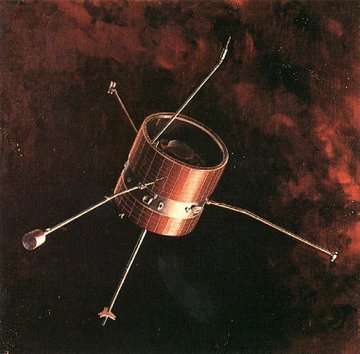Pioneer 8

Pioneer 6, 7, 8, and 9.
Pioneer 8 was the third of four identical solar orbiting, spin-stabilized spacecraft –
Pioneer 6, 7,
8, and 9 – in the Pioneer series of deep space probes. Pioneer 8 was launched on 13 December 1967 and
was still functioning, along with one of its science experiments, when last
contacted on 22 August 1996. On that date it was commanded to switch to its
backup transmitter and a downlink signal was re-acquired.
Pioneer 8's main body is an aluminum cylinder 94 centimeters (37 inches) in diameter
and 89 centimeters (35 inches) long. There are three magnetometer booms, each 208 centimeters (82 inches) long. The antenna mast (pointing down in the
picture) is 132 centimeters (52 inches) long. The mass is approximately 63 kilograms (138 pounds).
79 watts of power was generated from the solar panels. The spacecraft is spin-stabilized at approximately 60 rpm, with the spin axis perpendicular to the plane of
the ecliptic.
Pioneers 6–9 demonstrated the practicality of spinning a spacecraft to stabilize
it and to simplify control of its orientation. Measurements made by these
probes greatly increased our knowledge of the interplanetary environment
and the effects of solar activity on Earth. New information was gathered
about the solar wind, solar cosmic
rays, the structure of the Sun's plasma and magnetic fields, the physics
of particles in space, and the nature of storms on the Sun which produce solar flares. This series of spacecraft
also discovered Earth's magnetotail (magnetic field tail away from the Sun). Simultaneous measurements by Pioneer
6 and 8 when they were 161 million kilometers apart allowed the most accurate determination
of the solar wind density to be made up to that point.
| launch date | Dec 13, 1967 |
| launch vehicle | Delta E1 |
| launch site | Cape Canaveral |
| orbit | solar; periapsis 0.992 AU; apoapsis 1.088 AU; period 387.5 d; inclination 0.057° eccentricity 0.046 |
| other designations | Pioneer-C |


